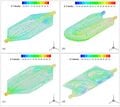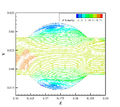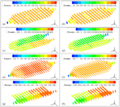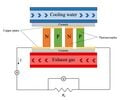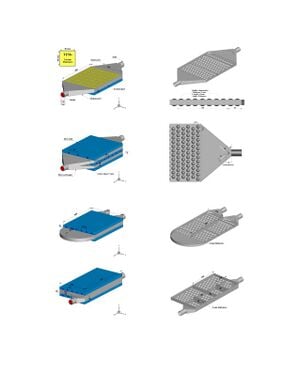
Abstract[edit | edit source]
The increasing energy demand and simultaneously growing concerns about pollution and climate change can clarify the importance of energy recovery, especially in the transportation section where a huge amount of fossil fuels is still consumed. Thermoelectric modules (TEMs) are one of the most stable means to extract energy from flue gases. However, the heat recovery by TEMs require a precise thermo-hydrodynamic design for heat exchangers to transfer more energy, owing to the low efficiency of the modules. Therefore, the current numerical study follows the ideas that can increase the efficiency of electrical power generation in vehicles. Three various simple or dimpled geometries, called Dual Flat, C-shaped, and U-shaped models, are introduced involving the ideas of chaotic flows, extending heat transferring surfaces, and intensifying turbulence levels. The number of TEMs is kept constant for all geometries and a trial procedure is performed to specify the thermo-physical properties of TEMs, directly connected to their hot and cold side temperature. The results are compared to the traditional Flat geometry, in terms of power generation, efficiency, and thermo-hydrodynamic evaluations. Dual Flat and Flat geometry are respectively labeled as the most and least power generating models by 45% relative difference. Despite the highest pressure drop, the chaotic flow in a C-shaped geometry provides the most efficient case if the pressure drop is freely provided by the engine exhaust inertia, while dimpled Dual Flat geometry is ranked the first for best efficiency when pressure drop compensation needs additional cost. The latter geometry can produce nearly 700 W power, as the maximum value.
Project Goals[edit | edit source]
- Increasing the net power generation rate compared to the previous designs
- Improving the uniformity of temperature distribution on the hot and cold surfaces of thermoelectric modules
- introduction of a thermo-hydrodinamic term to calculate the efficiency of the heat recovery system
- Evaluation of the effectiveness of chaotic flow on net efficiency of the heat recovery system
Numerical Method[edit | edit source]
In the current project, a CFD simulation was conducted in order to investigate the net power generation and the efficiency of a set of thermoelectric modules (TEMs) mounted on different heat exchangers. Further, the pressure drop and the temperature distribution of heat exchangers were also monitored. The Current study compares three newly designed heat exchangers namely Dual Flat, U-shaped and C-shaped geometries with the traditional flat model. Real working condition of an internal combustion engine were applied and the best engine case was chosen for each geometry in terms of net power generation. According to the dependency of TEMs' thermo-physical properties to the hot and cold side temperature of the modules, the thermal conductivity of the modules was carried out through a trial procedure.
Highlights[edit | edit source]
- C-shaped model was the most efficient geometry when free flow pressure was available.
- Dual Flat model was the most efficient geometry when pressure drop imposed an additional cost to the system.
- Dual Flat and Flat geometries generated the maximum and minimum amount of power.
- Heat transfer to the TEMs showed the peak value for U-shaped and C-shaped geometries.
- The Dual Flat geometry was the most influenced heat exchanger by dimples.
Source[edit | edit source]
- Taherzadeh Fini, A, Hashemi, SA, Fattahi, A, “On the efficient topology of the exhaust heat exchangers equipped with thermoelectric generators for an internal combustion engine”, Energy Conversion and Management, Vol. 268, (2022). https://doi.org/10.1016/j.enconman.2022.115966
Image Gallery[edit | edit source]
-
Flue gas Streamlines in heat exchangers
-
CFD results of flow regime and recirculation zones in dimples
-
Contours of exhaust gas pressure drop inside the heat exchangers
-
The structure of a thermoelectric module
